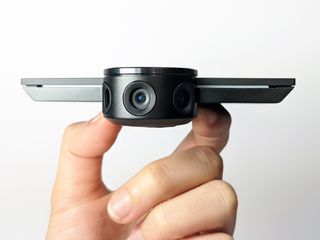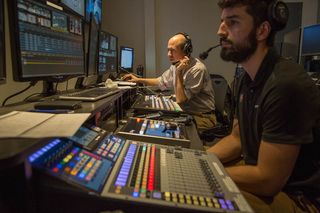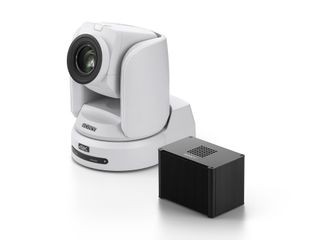The higher education classroom is now a playground of digital delights: laptops, smartphones, tablets, projectors, flat-panel displays, VR stations, AR kits, and more. A breathtaking array of video solutions is available at various price points to help education communities minimize barriers while maximizing opportunities for collaboration. From PTZ cameras for lecture capture, to laser projectors, to Sony’s AI-equipped system that can extract handwriting (yes, handwriting), universities are investing in new video tools.
The classroom video revolution is not without its challenges, however. Budget limitations and network strain are a few obstacles faced by AV integrators and end users. There’s also an emphasis on the student experience and general user experience (UX)—both on- and off-site. The new UX focus is inspiring some integrators to rethink traditional sales models.
State of Video in Education in 2019: Critical
For digital natives, video is not a bonus—it’s a non-negotiable necessity. Network connectivity is expected across the higher ed landscape. Students want to access course materials and recorded lectures as easily as Google searching. They want custom playlists and curated content. Similarly, the evolution of asynchronous (distance and flipped) learning, BYOD, and active learning have converged. Universities that have not invested in their networks—or modernized their spaces and pedagogies—will be disadvantaged. More degrees are going online, from undergrad to master’s degrees, business school to MFAs in journalism. Enrollment and retention have never been more important for university stakeholders.
Beyond creating a supportive (and affordable) learning environment, one way to attract and retain students is by providing relevant tools. According to The State of Video in Education 2019, a new survey of 1,400 students, primarily in higher education, 99.5 percent of students say that “video skills are needed in today’s workplace.” Eighty-six percent of students think that educators should actively help students acquire video skills. What’s more, 82 percent of those surveyed think that “students will increasingly expect video in their education experience.”
Kaltura’s findings tell a compelling story: meet students—and their needs—or they may go elsewhere. (Editor’s note: While Kaltura is a video vendor, its 2019 survey methodology is transparent and rigorous. It’s available via kaltura.com.)
Brighter, Lighter, Faster
AV-over-IP and HDBaseT designs are bringing enhanced AV connectivity to campuses large and small. AV endpoints themselves are fully-featured, often IP-based, supporting remote monitoring and data capture.
For Crestron, the key to staying ahead in the classroom video conversation is to develop systems that substantively increase collaboration. For example, the Texas A&M University College of Engineering has deployed 700 Crestron DM NVX encoder/decoder devices to enable the quick distribution of content from students’ and instructors’ laptop computers within the school’s active learning classrooms.
In the new Embry-Riddle Aeronautical University Student Union, Panasonic’s display solutions were integrated in conference rooms, group study spaces, and communal areas—including the TV lounge and game room. This project, a partnership with the AV consultancy Mediatech, included the installation of a 3x3-video wall in the Student Gallery, 27 digital signage displays in group study spaces and hallways, one 90-inch 4K professional display in a training room, and 12 projectors in the event center. The video systems were installed to amplify the “wow” factor to help support student engagement.
Panasonic strives to bring projectors to market that support reduced installation time. At InfoComm, the company debuted its PT-MZ16K Series 3LCD Laser Projector line anchored by a 16Klm Solid Shine 3LCD laser model. It supports uncompressed 4K60p signal input via HDMI or Digital Link.
Sony is also meeting the increasing demand for high-brightness and quick-to-install projection in multipurpose environments like universities with its new VPL-FHZ75 and VPL-FHZ70 models. Offering WUXGA resolution, both projectors use a 0.76-inch LCD panel with an incorporated optical compensator.
Mandate to Collaborate
1 Beyond, AMX by Harman, Atlona, Aveo Systems, Barco, BTX Technologies, ClearOne, Crestron, Intel, Kramer, Mersive, Nureva, Oblong, and ScreenBeam are just a few of the manufacturers leveling up their video collaboration solutions with wireless content sharing.
At InfoComm, Jabra made waves with PanaCast, an intelligent panoramic video system that integrates three 13-megapixel cameras, stereo microphones, and advanced software to deliver 180° video coverage, audio capture, and data sensing.

Also notable at InfoComm was the ScreenBeam 1100, a 4K multi-network wireless screen sharing solution that doesn’t require an app, offering flexible connectivity for wireless presentations.
Video is a Career Path
NewTek’s Brian Olson, vice president of product management, sees classroom video on the upswing in 2019. Not only is there more video than ever before, “there are new ways of integrating it into the classroom,” he said. You’ll certainly find the expected offerings—flat-panels, projectors, lecture capture, and streaming—but there is another side to the campus video equation: teaching media production. NewTek outfits many of the tools used in production classes and by production teams. It also helps institutions by serving as a pedagogical partner. The company has created a curriculum designed to support film/video/media production.

Leveraging the IT Network for Video
Olson explained that because of NewTek’s development of the NDI IP video protocol, “We’re getting more involved in distribution of a video within education, aspects like lecture capture, webcasting, streaming, social media, and creating video for social media.”
As lauded as lecture capture is, esports and sports broadcasts are just as popular. “We’re seeing a lot more schools take on coverage of all kinds of sports within their institutions, saying, ‘We have live production here, and we can do our own live replay and streaming.’”
Schools are using NDI in unexpected and innovative ways, Olson added. “Some are taking our portable NDI converters that are Wi-Fi-enabled, and they’re doing wireless video from inside the field or the court. They don’t have to run cables.”
With NDI infrastructure, schools can now leverage the IT backbone for the distribution of video. During production, for example, if users want to tie in cameras from another campus building, they can do so just by connecting to a nearby Ethernet port, and then working on production in a different part of the campus. “This is really empowering for a lot of people,” said Olson.
Speak Their Language
Every organization is nuanced; it’s paramount to understand specific user needs for video, as well as the university’s requirements for network security and accessibility.
For John Garmendi, senior manager, education solutions, Sony, AV security and UX are so important that “our team is comprised of a number of specialists, including a solutions architect to speak the language of the security teams and make sure we are fully compliant with university requirements.”
More Content, More Cloud
User-generated content and cloud integration are also trends influencing video adoption. Sony’s UbiCast is a new cloud-based, automated solution that lets organizations create and share rich media video for learning, training, and webcasting.
“We design educational solutions with the faculty in mind,” said Terry Huber, senior marketing manager of the corporate and education division of Sony. “Our video collaboration learning solution, Vision Exchange, uses drag-and-drop functionality to make it easy for professors to use. It’s not menu-driven, so it is very simple for every teacher to use. Combined with UbiCast, content can be easily created and remotely captured.” Native LMS integration further streamlines the setup.
AI, AV, Inclusion
AI continues to gain momentum in higher education. “Predictive analytics can help determine student success and red-flag any potential struggles early,” said Garmendi. “This is really important. An inclusive environment is one that supports all students—regardless of learning or social challenges. AI is proving to be a useful tool to identify potential obstacles to success.”
Video analytics by vendors such as Sonic Foundry can help instructors focus their content by revealing which segments students had to rewatch.

Sony is addressing the demand for both content and AI in another way. Its REA-C1000 AI-based Edge Analytics Appliance allows users to create video content in real time, without the need for specialized training, additional staff, or equipment. This technology uses motion/face detection and color/shape recognition, enabling the REA-C1000 to be the brain of any connected camera and AV setup, according to Sony.
Personalization and customization of the learning and teaching experience are also capturing stakeholders’ imaginations. While still emerging, expect to see more R&D in systems that can tap the power of AI to recognize a faculty member as she walks into a classroom, then instantly open a distance learning or LMS portal, for example.
Staying Current as Video Needs Change
To stay agile as the industry evolves, Garmendi suggested: “Keep the pulse on SaaS [Software as a Service] and video with cloud integration.” Rethink the sales structure to offer services and support that can help universities manage facilities more efficiently.
[The Education Market Can Provide Multiple Learning Opportunities with Live Video Integrations]
“Technology as a Service is one option. Unburdening or centralizing [technology] management would be welcomed by universities, as it’s something they struggle with,” he added.
As schools update legacy systems and migrate from hardware silos to more software-driven, UX-focused approaches, integrators will be uniquely positioned to provide more data and holistic management solutions for connected endpoints. A useful resource for classroom video stakeholders is the AVIXA report AV/IT Infrastructure Guidelines for Higher Education.
Ultimately, the video technologies of the future must be collaborative, Garmendi said. “The focus has to be on student success and increasing the learning outcomes for all.”













